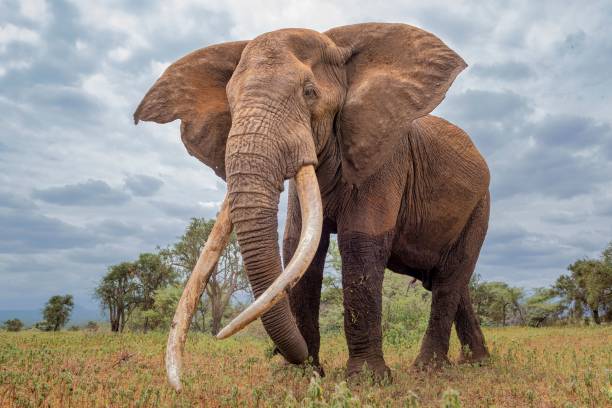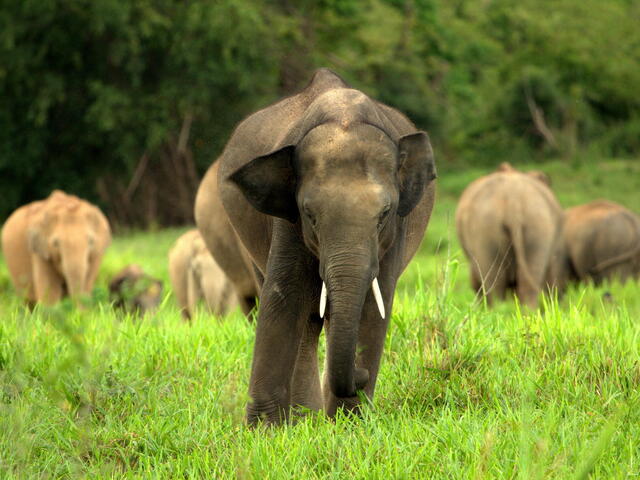The elephant is the largest land animal on Earth, known for its strength, intelligence, and memory. Despite its size, the elephant is gentle, social, and deeply connected to its herd. These majestic animals are part of nature and human life culture across Africa and Asia.
Scientific Classification
-
Kingdom: Animalia
-
Phylum: Chordata
-
Class: Mammalia
-
Order: Proboscidea
-
Family: Elephantidae
-
Genus: Loxodonta (African), Elephas (Asian)
Common Names
-
Elephant
-
“Erin” (Yoruba)
-
“Giwan” (Hausa)
-
“Nnanyi” (Igbo)
-
“Tembo” (Swahili)
In different languages and cultures, elephants are often respected and even worshipped.
Geographic Distribution
Elephants are found in Africa and Asia, mostly in:
-
Savannas and forests
-
Swamps and grasslands
-
Protected reserves and national parks
African elephants roam in countries like Kenya, Nigeria, South Africa, and Ghana.
Asian elephants live in India, Sri Lanka, Thailand, and Southeast Asia.
 Image showing African elephants walking across the savanna with a cloudy sky (Source: Pexels)
Image showing African elephants walking across the savanna with a cloudy sky (Source: Pexels)
Physical Characteristics
Elephants have large ears, strong legs, and long trunks. Their tusks are made of ivory.
-
African elephants have larger ears shaped like Africa
-
Asian elephants have smaller ears and more rounded backs
-
Their trunks are used for eating, drinking, touching, and greeting each other
-
Tusks are used to dig, defend, and strip tree bark
They weigh between 2,700 to 6,000 kg and can live for 60–70 years.
Types of Elephants
1. African Bush Elephant (Loxodonta africana)
This is the largest elephant species, found in African savannas and forests.
 Image showing African bush elephant with large ears and tusks in a grassy field (Source: iStock)
Image showing African bush elephant with large ears and tusks in a grassy field (Source: iStock)
Key Facts:
-
Very large body and wide ears
-
Both males and females grow tusks
-
Highly social and herd-oriented
-
Needs lots of space and water
2. African Forest Elephant (Loxodonta cyclotis)
A smaller and shy type of elephant living in thick forests.
 Image showing African forest elephant walking through dense forest (Source: Freepik)
Image showing African forest elephant walking through dense forest (Source: Freepik)
Key Facts:
-
Shorter and straighter tusks
-
Rounded ears
-
Lives in rainforests of Central and West Africa
-
More endangered than bush elephants
3. Asian Elephant (Elephas maximus)
Found across India, Sri Lanka, and Southeast Asia. Smaller than African elephants.
 Image showing Asian elephant in a forest (Source: WWF)
Image showing Asian elephant in a forest (Source: WWF)
Key Facts:
-
Only some males have tusks
-
Smaller ears and smoother skin
-
Used for work and ceremonies in Asia
-
Needs forest cover and gentle care
Behavior and Lifestyle
Elephants are highly intelligent and live in family groups led by an older female (matriarch).
-
They use trumpeting sounds and body language to talk
-
Elephants mourn their dead and remember friends and enemies
-
They travel in herds and protect their young carefully
-
Elephants need daily access to water and 150+ kg of food
They are also excellent swimmers and love mud baths to cool their skin.
What do elephants eat?
Elephants are herbivores and eat:
-
Grass, leaves, bark, and fruits
-
Banana stems, sugarcane, bamboo (Asian elephants)
-
Water lilies and reeds (in wet areas)
They spend 12–18 hours a day feeding and can drink up to 200 liters of water daily.
Fun facts
-
Elephants can recognize themselves in a mirror, a sign of deep intelligence.
-
A baby elephant is called a calf and weighs about 100 kg at birth.
-
Their trunks have over 40,000 muscles and can pick up a peanut or pull a tree.
-
Elephants grieve and touch the bones of dead herd members.
-
The sound of an elephant’s trumpet can be heard from several kilometers away.
Importance to Humans
Elephants are deeply connected to human life, both positively and negatively.
Positives:
-
Used in tourism, transportation, and traditional ceremonies
-
Important in ecosystem balance, spreading seeds and clearing paths
-
Source of art and storytelling in many African and Asian cultures
Negatives:
-
Can damage crops or water tanks in farming communities
-
Sometimes involved in human-wildlife conflict
-
Illegal poaching for ivory threatens their survival
Health & common issues
Elephants face many health challenges in the wild and in captivity.
Common health concerns include the following:
-
Foot rot and joint pain due to long walking
-
Worms and parasites, especially in hot areas
-
Wounds from traps or human conflict
-
Stress and boredom in captive elephants
Veterinary Needs:
-
Regular foot care and nail trimming
-
Large, clean space with shade and water
-
Mental stimulation and proper diet
-
Vaccination against infectious diseases
Conservation Status
All elephant species face serious threats and need protection.
-
African Forest Elephant: Critically Endangered
-
Asian Elephant: Endangered
-
African Bush Elephant: Endangered
Main Threats:
-
Poaching for ivory
-
Habitat destruction due to farming and roads
-
Climate change and water shortages
Conservation Efforts:
-
Anti-poaching patrols
-
Elephant sanctuaries and protected areas
-
Laws banning ivory trade
-
Wildlife education and tourism programs

















Reviews
There are no reviews yet.